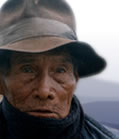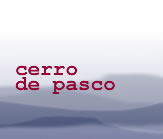THEMES IN THIS
TESTIMONY
Communications

Culture and Customs

Festivals

Land

Livestock

Spiritual Beliefs

Click on arrows
to find more
testimonies
featuring
these themes
|
|
Sex
|
male
|
|
|
Age
|
old
|
|
|
Occupation
|
local history researcher
|
|
|
Location
|
Rancas
|
|
|
Date
|
1995
|
|
summary
Vicente grew up in the country on a farm, never going to the town. He went to school in the town at the age of 22 and felt he never quite integrated. He gives a sensitive, somewhat idyllic account of rural life and the way he felt as a country boy in the city. He started the Manuel Scorza Cultural Grouping and has now become a prominent local figure, an authority on cultural and social issues and concerned with preserving local culture.
He provides a detailed and interesting description of the most important rural feast, the animals' feast (Mezachunllay Auquillo) celebrated around Carnival, and the social/ritual significance of this. He has an extensive knowledge of local legends and also gives a detailed and vivid account of a neighbour's discovery of the lost old town of Rancas. Right at the end of the interview he tells a story recalling the Huayllacancha massacre of campesinos and how their ghosts terrorised the gringo (North American) owners of the Paria Estate: “This shows how afraid they were of clashing with the campesinos. The gringos' imagination had run away with itself.”
detailed breakdown
|
You will need a password from Panos to view the full
transcript of the interview. To apply for a password, click here.
Once you have a password, click here to go to the beginning
of the transcript. You can also click on any section of the
breakdown of content below and go straight to the
corresponding part of the transcript.
|
| Section 1 |
His childhood on an isolated rural farm - very happy and in harmony with nature but cut off from 'progress', especially media access. Went to study in the town at the age of 22 - feelings of inferiority because he was a peasant farmer in urban setting. There were marked differences between town and country folk then, but there are less now.
|
| Section 1-2 |
Detailed description of his discomfort with town life (bustle, noise, violence etc) and the monotony compared to the ever changing landscapes in the country.
|
| Section 2 |
Children's life: games and work, and friendship on the farm, compared to violence and disdain amongst kids in town. When in the town he lost himself in his books and was an outstanding student.
Through his parents learnt some history of how different mining companies expropriated the land from campesinos. Rancans also exploit mineral resources now with businesses linked to mining industry. Severe pollution as a result of the mining and impact on surrounding lands - soil, rain, rivers and wind.
|
| Section 3 |
His community work with young people. Set up Manuel Scorza Cultural Grouping in Rancas, into 'cultural recovery' tradition collecting stories, local history, setting up music and theatre groups - performed in Lima. Also Radio Rancas - important communication with town and country folk.
Very detailed description of most important rural feast - animals' feast - describes traditions and ritual, including offerings to the mountain, marking the animals, significance of coca and liquor, etc, to ensure good health and multiplication of the animals for coming year.
|
| Section 4 |
Description of significance of each day in the animals feast (almost 1 week), marking the animals, partying, dancing, games, etc.
|
| Section 5 |
Form of fiesta(festival, celebration) is passed through generations; some changes but not many. It has become shorter now for some, because of economic problems. In rural areas this is a family feast, whereas in the town the whole population celebrates it. Town folk work individually and are losing their links with the land, whereas campesinos still have a relationship with the land.
Patron saint of town is San Antonio
|
| Section 5-6 |
Legend of old town of Rancas, now at bottom of Lake Aleacocha. Tells a lively and detailed story of a neighbour who got drunk, disappeared for days and when he re-emerged claimed he’d been celebrating in/with the old town. Next year he went there same time but entirely sober, and again heard the sounds of celebration from the lake - proof that old Rancas celebrates same patron saint on same day.
|
| Section 6 |
Another story of San Antonio's “miracles” - linked to impact of the gringos on the community but showing their fear of campesinos after the Huayllacancha massacre.
|
|


